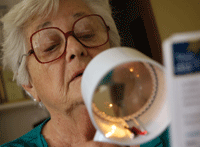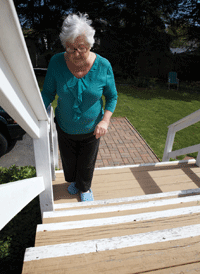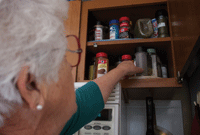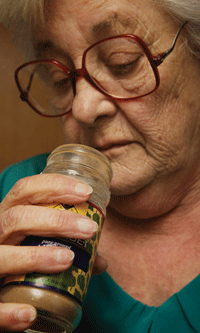In 2002, Dottie Copoulos knew something was wrong. The then 69-year-old former geriatric nurse from Peabody, Mass., recognized that her vision symptoms were getting worse.
She was already aware that she had floaters. But now, when she inspected her flowers from her backyard deck, the avid gardener couldn’t distinguish her roses from her clematis plants.
Mrs. Copoulos, whose mother suffered from advanced age-related macular degeneration, realized she was losing her central vision. But she still was not prepared to hear her ophthalmologist’s diagnosis as she anxiously sat in his exam chair a decade ago.

In addition to her regular job, Dottie Copoulos wrote a weekly health care column in the local newspaper. Now with advanced AMD, she can’t even read the newspaper.
“I always liked my doctor. He had good credentials and was considered the best eye doctor in the area,” Mrs. Copoulos recalls. “But I will never forget how he told me I had AMD. He said, ‘I’ve got good news and bad news. The bad news is that your eyes progressed to the point that I have to report you to the Division of the Blind and you will be hearing from the DMV. You won’t be able to drive anymore, Dottie. But the good news is that you are going to get a rebate on your taxes and you won’t have to pay excise tax on your car anymore.’”
Mrs. Copoulos, a normally cooperative and pleasant patient, says this time she erupted.
“I said, ‘What are you talking about? You are telling me I can’t drive but I won’t have to pay excise tax on my car?’ He was naming off all the benefits I would receive from being blind,” she says. “I got so upset, I walked out. My doctor’s nurse called me at home later and apologized. She said my doctor just got back in the office after back surgery and was in a lot of pain. I told her that he should have waited another day to come back to work then.”
Even though deep down she knew she had AMD, hearing the diagnosis—and the way in which it was delivered—was still jarring.
Break Bad News the Right Way
Informing a patient about a devastating eye disease is a delicate but critical factor in the diagnosis.
The best way to break bad news? “Be direct and straightforward,” says Marc Gannon, O.D., founder and director of the Low Vision Institute in Fort Lauderdale, Fla.
“First, you need to let the patient know what the condition is,” he says. “Second, you need to define and explain the disease. Let them know the ramifications and the actions they can take so they are not left without hope.”
Simply giving the patient a brochure to read when they get home is not appropriate, especially since many patients with eye disease have already lost their ability to read.
Also, you obviously don’t want to tell a patient that there is nothing that can be done.
“Be honest and give them a good working knowledge on what they can do to preserve their vision and the options available to them,” Dr. Gannon adds.
Macular degeneration is the most common cause of vision loss in older adults, and it is important to reinforce to the patient that there is life after the diagnosis, he says.
“I hope by the time they leave the office, the patient is equipped with an understanding of their condition and [the knowledge] that it is not a hopeless situation at all,” Dr. Gannon says. “Life isn’t over, and they can learn how to compensate in the areas of their lives they wish to preserve.”
“It’s like hearing you have cancer,” she says. “When you hear those words, you’re never prepared for anything like that.” (See “Break Bad News the Right Way”)
Today, Mrs. Copoulos joins the estimated two million Americans over age 50 who have advanced AMD.
And, while science and clinical research continue to make strides in finding better treatments, patients like Mrs. Copoulos learn to adapt and carry on with their day-to-day lives as their vision continues to worsen.
Here, she shares her first-hand experience on what it is like to live with advanced AMD.
Making Adjustments
For three decades, Mrs. Copoulos ran the nursing divisions of several large Massachusetts convalescent homes. She raised three children, was a regular participant in the Harvard Nurses’ Health Study and wrote a weekly health care column, “Ask Dottie,” in the local newspaper.
When Mrs. Copoulos did carve out time for herself, she was a voracious reader. Since her AMD has progressed to both eyes, the now 79-year-old. Mrs. Copoulos can’t read books anymore.

Dottie Copoulos’ husband painted thick white lines along the edges of their outside steps so she can see them better when she goes in and out of their home.
“I go through three books on CD a week. I have a player in my bedroom and a portable one I carry around with me. I just love it,” she says.
Mrs. Copoulos tries to compensate for what she has lost due to AMD and keeps a positive attitude. In addition to losing her ability to read, she can’t drive anymore and has to rely on others for rides to get around to appointments, lunches or trips to the grocery store. And, seemingly small—but yet once important—routines have also fallen by the wayside.
“I used to love to put on eye shadow, but now, when I’m through, I look like a clown. And, forget about tweezing,” she says with a laugh. “Things I used to do for personal appearance and normal morning routines have changed for me. But what can you do?”
Mrs. Copoulos admits she loves a good sale, but she can’t go to stores alone anymore. With AMD, numbers on the tags are too hard to read, especially if the price contains any circular number such as a three, a six or an eight.
“With macular degeneration, you lose part of the figure, so the threes look like eights and the sixes look like threes. I have to always have someone with me. You lose your independence,” Mrs. Copoulos explains.
In fact, losing her independence has been the hardest part of coping with AMD, she says. “I hate being dependent on people for certain things. That’s my personality, it might not bother other people as much, but it bothers me. I used to be able to paint the whole house by myself, but now I can’t do it anymore.”
Mrs. Copoulos has no shortage of friends and family who want to help, but sometimes the help backfires. Because she now has only peripheral vision, Mrs. Copoulos arranges everything in her house precisely so she will know exactly where it is when she needs to use it, including her spices in her spice rack. When someone comes over to visit and insists on lending a hand in the kitchen, the spice rack gets rearranged; this may seem trivial for most, but not for Mrs. Copoulos.
“It’s annoying. I put all the spices I use the most in the front and the ones I use for baking I put separately,” she says. “A lot of my girlfriends and sisters come here and they want to help me but I say, ‘Don’t help me,’ because it just confuses me. I’ve messed up many meals because of my spice rack. If things are where I put them, I do well.”
Making change at the checkout line or leaving tips in restaurants or at the airport are no easy tasks either, so Mrs. Copoulos has to carefully arrange her wallet in denominations. She learned this the hard way years ago after tipping a porter $50 instead of $5. “That was one happy porter,” she says.

Mrs. Copoulos has the jars in her spice rack memorized. If someone comes over to lend a hand in the kitchen, the spices always get rearranged.
Mrs. Copoulos continues to be active, even though she may be moving at a slower pace. She still goes to the movies with friends although now she can only hear the sound, and she has kept her sense of humor intact.
“My husband Alex is legally deaf, and I’m legally blind,” she says. “Alex will be driving us down the highway, and he’ll say ‘I told you to watch for Exit 16 and we just missed it.’ I tell him, ‘If I could see Exit 16, I would be driving.’”
Although her children have encouraged her to move into a one-level house, Mrs. Copoulos is reluctant, as she has 50 years of history and memories in her Peabody home. So, she makes do. Mrs. Copoulos stays on one floor of the house so she doesn’t need to navigate the stairs, and her husband, Alex, painted a thick white line along the borders of their outside steps so Mrs. Copoulos can see them better when she goes in and out of their home.
“I am afraid to do a lot of walking. If you trip, you can’t see where you are falling,” Mrs. Copoulos says. “I walk very slowly, and it’s not because I’m in pain; it’s because of my fear of falling. I hate the white cane. I won’t use it yet, so when I walk I always need to have someone with me.”
Visual Aids and Studies
When Mrs. Copoulos was first diagnosed with AMD, she says the Division of the Blind was extremely supportive. A social worker paid her a visit at her home and her doctor provided her with visual aids including a large illuminated magnifier and thick telescopic glasses that she used to watch television. But now, as her AMD has progressed, she just listens to the sound coming from the set.
Even before she had floaters, the former geriatric nurse read about the AREDS study and began to take the recommended formulation of vitamins and minerals, knowing her family history of AMD. Now Mrs. Copoulos encourages her own three children to take ocular vitamins in an effort to potentially prevent the onset of vision loss, since studies have indicated AMD can be inherited genetically.

If someone comes over to lend a hand in the kitchen, the spices always get rearranged. Then she has to figure out which spice is which by using her sense of smell.
Mrs. Copoulos has also participated in several AMD studies in Boston during the past decade, including a controlled study where she took a pill for one year. “I’m not sure if I was in the placebo group or not, but whichever group I was in, it didn’t work. That’s life though. As a geriatric nurse, I knew what I was getting into.”
Although Mrs. Copoulos’s vision continues to decline, she is realistic but still hopeful that one day science will find a cure. “I read about these new studies and miracles, but those success stories are a very small percent. But, whatever comes around that is new, I am willing to try it,” she says.
Mrs. Copoulos has had to adapt her lifestyle to cope with AMD, but she says that she hasn’t let it take over her life. “It takes me longer to do things and I am more cautious,” she says. “But, I won’t let it stop me from doing anything. It might take me longer, but I will get there.”

